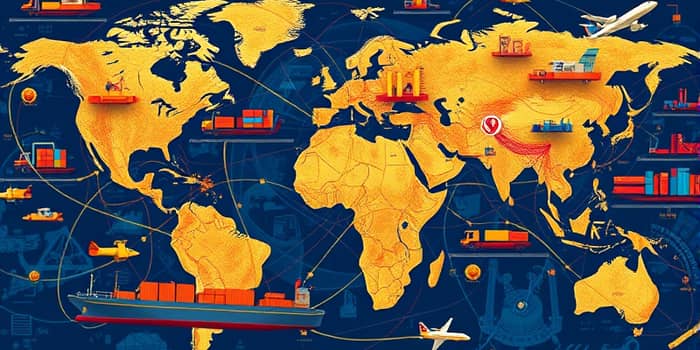
In an era of unprecedented connectivity, businesses rely on global supply chains to source materials, manufacture products, and deliver finished goods to customers around the world. A supply network that spans continents brings remarkable efficiencies but also introduces a wide range of vulnerabilities that can disrupt operations, erode margins, and damage reputations. By examining the structure, data-driven trends, and major risk factors, leaders can build more agile and resilient systems capable of thriving in a volatile environment.
A complex, multi-tiered global system begins with raw materials and extends through manufacturing, logistics, distribution, and final delivery to end-users. In essence, a global supply chain is an international network of suppliers, manufacturers, logistics providers, distributors, and retailers that coordinate the flow of goods, information, and finance across borders to meet customer demand. Four key phases define the life cycle of every product:
Within these phases, core components work in tandem to ensure smooth operations:
Consider a modern smartphone: minerals mined in Africa, microchips assembled in East Asia, software engineered in North America, and final products shipped globally. This extensive cross-border collaboration and coordination illustrates how no single region can operate in isolation, making every link in the chain critically important.
Recent data underscores the fragility of interconnected networks. In 2024, more than 76% of European shippers experienced supply chain disruptions, with almost a quarter reporting over 20 incidents and a third facing material shortages that halted production lines. As a result, fewer than 8% of businesses feel fully in control of emerging risks, and 63% report losses exceeding initial expectations.
Labor markets are under pressure, too: 62% of supply chain leaders cite labor shortages as a top short-term threat, prompting 38% of manufacturers to launch reskilling and retraining initiatives. Economic uncertainty looms large, with 56% of chief economists predicting weaker global conditions in 2025 and 61% of CEOs bracing for persistent inflation and low growth.
To adapt, only 31% of corporations have activated contingency plans for shifting tariffs and regulatory changes, often in response to geopolitical events such as trade disputes between major powers. As disruption events become the norm rather than the exception, data-driven planning and real-time visibility emerge as critical success factors.
Supply chain risks fall into broad categories—economic, environmental, political, and ethical—each presenting unique challenges and demanding specialized mitigation tactics. Businesses must constantly monitor multiple risk vectors to anticipate and manage disruptions effectively.
Additional threats include supply shortages of critical materials, increasing cargo theft, stringent regulatory compliance demands, and ethical concerns such as forced labor. Pandemic-related risks have declined—only 13% of firms list health crises as a major concern in 2025, down from 23% two years earlier—yet the memory of massive shutdowns continues to influence contingency planning.
Advancements in technology are transforming how companies manage and secure their supply chains. Artificial intelligence powers demand forecasting and inventory optimization, enabling managers to balance stock levels dynamically while reducing waste. Blockchain solutions enhance traceability, verifying product origins and combating fraud through immutable ledgers.
The Internet of Things unleashes real-time tracking of goods via embedded sensors and GPS devices, offering granular visibility into shipment conditions. Automation and robotics accelerate warehouse operations, while cloud computing platforms facilitate real-time monitoring and predictive modeling across multiple geographies. However, digital systems also introduce vulnerabilities: cybersecurity attacks surged over 400% between 2021 and 2023, with supply chain incidents growing 34% in the past year and average breach costs exceeding $4.4 million.
To build robust operations, organizations are embracing proactive measures that blend analytic insights with strategic planning. Central to this effort is supplier diversification and resilience, ensuring no single provider controls critical inputs. Comprehensive supply chain mapping illuminates hidden dependencies and single points of failure, empowering teams to redesign flows before disruptions occur.
Digital dashboards and API integrations now offer executives a unified view of key performance indicators, risk alerts, and scenario modeling. Collaboration across procurement, logistics, finance, and legal teams has become a best practice, fostering agility and rapid response when challenges emerge.
Looking ahead, the race to build sustainable supply chains intensifies as stakeholders demand greener processes and transparent sourcing. Companies face a growing emphasis on sustainability goals that encompass carbon reduction, circular economies, and socially responsible labor practices. Simultaneously, consumer expectations for fast, traceable delivery continue to rise, pressuring businesses to innovate endlessly.
Geopolitical uncertainty and shifting trade agreements are prompting a shift from globalization toward multi-local and nearshoring strategies, balancing cost efficiencies with risk mitigation. Industry experts rank artificial intelligence, looming cyber threats, evolving regulations, and climate resilience as top priorities for 2025 and beyond.
In this dynamic landscape, success will hinge on the ability to integrate cutting-edge technology, cultivate strong partnerships, and maintain a flexible mindset. By embracing change as an opportunity rather than a threat, organizations can transform fragile networks into engines of growth, ready to deliver value in any environment.
References





